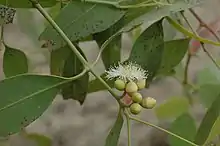| Weeping box | |
|---|---|
 | |
| Eucalyptus patellaris flower buds and flowers | |
| Scientific classification | |
| Kingdom: | Plantae |
| Clade: | Tracheophytes |
| Clade: | Angiosperms |
| Clade: | Eudicots |
| Clade: | Rosids |
| Order: | Myrtales |
| Family: | Myrtaceae |
| Genus: | Eucalyptus |
| Species: | E. patellaris |
| Binomial name | |
| Eucalyptus patellaris | |
Eucalyptus patellaris, commonly known as weeping box,[2] is a species of tree that is endemic to the Northern Territory in Australia. It has rough, fibrous to flaky bark on the trunk and branches, lance-shaped or curved adult leaves, flower buds in groups of seven, white flowers and bell-shaped or cup-shaped fruit.
Description
Eucalyptus patellaris is a tree that typically grows to a height of 10–18 m (33–59 ft) and forms a lignotuber. It has rough, greyish, flaky or fibrous bark on the trunk and branches. Young plants and coppice regrowth have dull green, egg-shaped leaves that are 90–135 mm (3.5–5.3 in) long and 35–60 mm (1.4–2.4 in) wide. Adult leaves are lance-shaped or curved, the same shade of green on both sides, 95–270 mm (3.7–10.6 in) long and 13–35 mm (0.51–1.38 in) wide, tapering to a petiole 8–26 mm (0.31–1.02 in) long. The flower buds are arranged on the ends of branchlets on a branched peduncle 5–25 mm (0.20–0.98 in) long, the individual buds in groups of seven on pedicels 4–12 mm (0.16–0.47 in) long. Mature buds are pear-shaped to oval, 9–16 mm (0.35–0.63 in) long and 6–9 mm (0.24–0.35 in) wide with a conical or beaked operculum. Flowering occurs from November to February and the flowers are white. The fruit is a woody, bell-shaped or cup-shaped capsule 6–12 mm (0.24–0.47 in) long and 6–13 mm (0.24–0.51 in) wide with the valves near rim level.[2][3][4]
Taxonomy
Eucalyptus patellaris was first formally described in 1859 by Ferdinand von Mueller in Journal of the Proceedings of the Linneany Society, Botany from material collected from the upper part of the Roper River.[5][6] The specific epithet (patellaris) is from Latin, meaning "pan" or "knee-cap", referring to the shape of the operculum in the original, possibly diseased buds.[7]
Distribution and habitat
Weeping box grows in open forest and woodland in gentle slopes and on river flats in the Top End of the Northern Territory in scattered locations. Some sources list this species as occurring in the Kimberley region of Western Australia, but recent research indicates that these specimens are a new species, E. xerothermica.[2][3][4]
See also
References
- ↑ "Eucalyptus patellaris". Australian Plant Census. Retrieved 27 November 2019.
- 1 2 3 "Eucalyptus patellaris". Euclid: Centre for Australian National Biodiversity Research. Retrieved 30 May 2020.
- 1 2 "Eucalyptus patellaris F.Muell". NT Flora. Northern Territory Government. 2016. Retrieved 12 November 2016.
- 1 2 Chippendale, George M. "Eucalyptus patellaris". Australian Biological Resources Study, Department of the Environment and Energy, Canberra. Retrieved 28 November 2019.
- ↑ "Eucalyptus parvula". APNI. Retrieved 28 November 2019.
- ↑ von Mueller, Ferdinand (1859). "Monograph of the eucalypti of tropical Australia". Journal of the Proceedings of the Linnean Society, Botany. 3: 84–85. Retrieved 28 November 2019.
- ↑ Francis Aubie Sharr (2019). Western Australian Plant Names and their Meanings. Kardinya, Western Australia: Four Gables Press. pp. 271–272. ISBN 9780958034180.